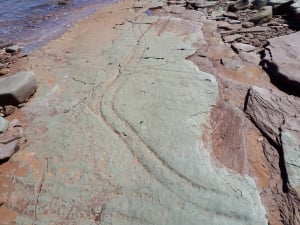A Significant Alabama Fossil Discovery
- Rockin' Ric's Blog

- Feb 11, 2020
- 2 min read
Updated: Feb 13, 2020
A friend and I discovered a "honey hole" fossil site several years back. We were pulling out fern fossils left and right as well as other plant fossils. I picked up small slab of stone with fern leaves on it and see this odd oval shaped image on the slab not knowing what it was. I called my friend over and looked at it and thought it appeared to be a portion of a crustacean/shrimp. I hearkened back to "The One That Got Away" incident and decided to keep this find, take a picture of it later and post it on The Fossil Forum to get an identification. Little did I know that small piece would become the first of it's kind found in the state of Alabama! Most of the fossils found today are up in the Northeast and Europe?

Over a period of time I had been corresponding with a paleontologist from Canada who did some trace fossil work in Alabama about my recent trace fossil finds. I posted the fossil discovery on my Facebook page and he saw it, contacted me saying what I found was a piece of Arthropluera Armata and needs to be in a museum! Several days later after he commented on the fossil I get this email from the Vice President of the Alabama Paleontological Society stating: "I heard today from Matt, an invert paleo guy in Canada who is about to publish a paper on invert traces at the Union Chapel Mine, that you had posted a shot of an Arthropleura body fossil on your Facebook site. If that is for real, it would be the first ever found in Alabama and would extend the range of that big bug to this area. He and Spencer Lucas the paleontologist at the New Mexico Museum of Natural History, would be very interested in writing a paper on it if you would be willing to donate it to a museum.

(Jun Ebersole would be happy to add it to the McWane collection). You would be given full credit as the finder of course. What do you think?" Throughout the week I heard from Fossil Forum members echoing the same sentiment showing pictures of the same type fossil! The Arthropluera thrived in a swampy environment during the Carboniferous Period (coal age) 300 million years ago. It grew to lengths of 6-8 feet. Below are pictures showing the scale (hammer handle) of the big bug and this one in particular was one big creepy crawly! These tracks were found in Nova Scotia. ~Photos courtesy of Luke Allen- tracks found on the coast of Nova Scotia.







Comments